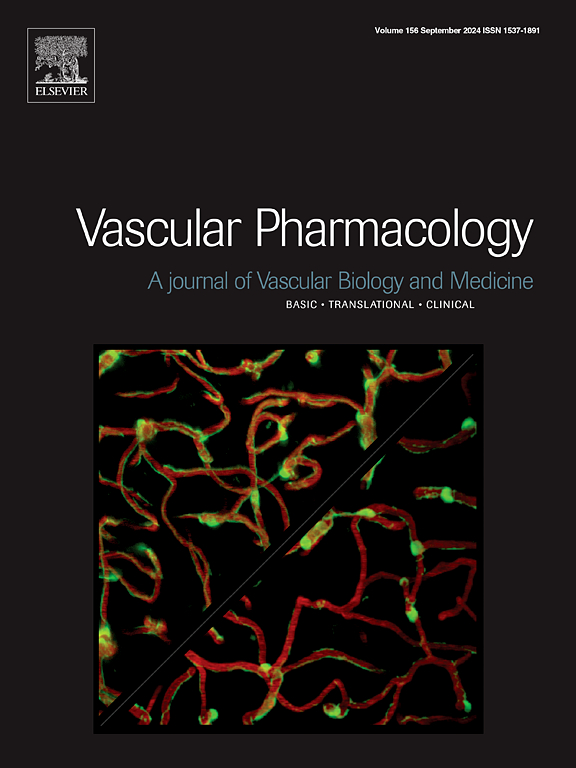fgf相关基因多态性对直接口服抗凝剂治疗的脑梗死患者的影响。
IF 3.5
3区 医学
Q2 PHARMACOLOGY & PHARMACY
引用次数: 0
摘要
背景:脑梗死的发生是多因素的,包括环境因素和遗传因素。本研究评估了直接口服抗凝剂(DOACs)患者中成纤维细胞生长因子(FGF)相关基因多态性与脑梗死发生率之间的关系。方法:选取在梨花女子大学木洞医院和梨花女子大学首尔医院接受doac预防脑梗死的18岁以上 心房颤动患者为研究对象。检测了来自FGF1、FGF2和FGFR1的21个单核苷酸多态性(snp)。在多变量logistic回归分析中,构建3个模型(模型1:仅人口统计学因素、模型2:人口统计学因素与遗传因素、模型3:遗传因素与CHA2DS2-VASc评分)来识别脑梗死相关危险因素。结果:536例候选患者中,21例(3.9 %)在服用DOACs时发生脑梗死。从模型I和模型II来看,年龄 ≥ 75 岁和既往血栓栓塞事件史增加了脑梗死的风险。对于II型和III型的遗传因素,FGF1 rs1596776 GG、FGFR1 rs6996321 AA和FGFR1 rs7012413 TT基因型与脑梗死的高风险相关。加入遗传因子后,受者工作曲线下面积由0.747(模型一)增加到0.822(模型二),模型性能较好。结论:本研究揭示了在接受DOAC治疗的房颤患者中fgf相关基因多态性与脑梗死之间的关联。本文章由计算机程序翻译,如有差异,请以英文原文为准。

Effects of FGF-related gene polymorphisms on cerebral infarction in patients treated with direct oral anticoagulants
Background
The development of cerebral infarction is multifactorial, including both environmental and genetic factors. This study assessed the association between fibroblast growth factor (FGF)-related gene polymorphisms and the incidence of cerebral infarction among patients on direct oral anticoagulants (DOACs).
Methods
Patients over 18 years old with atrial fibrillation who were receiving DOACs for cerebral infarction prevention at Ewha Womans University Mokdong Hospital and Ewha Womans University Seoul Hospital were enrolled in this analysis. Twenty-one single nucleotide polymorphisms (SNPs) from FGF1, FGF2, and FGFR1 were examined. In multivariable logistic regression analysis, three models (Model I: demographic factors only, Model II: demographic factors and genetic factors, and Model III: genetic factors and the CHA2DS2-VASc score) were constructed to identify the risk factors related to cerebral infarction.
Results
Among the 536 candidate patients, 21 (3.9 %) experienced cerebral infarction while taking DOACs. From Model I and Model II, age ≥ 75 years and previous thromboembolic event history increased the risk of cerebral infarction. For genetic factors in Model II and III, FGF1 rs1596776 GG, FGFR1 rs6996321 AA, and FGFR1 rs7012413 TT genotypes were associated with a higher risk of cerebral infarction. The area under the receiver operating curve increased from 0.747 (Model I) to 0.822 (Model II) by adding genetic factors, demonstrating better model performance.
Conclusions
This study uncovered the association between FGF-related gene polymorphisms and cerebral infarction among patients with atrial fibrillation undergoing DOAC therapy.
求助全文
通过发布文献求助,成功后即可免费获取论文全文。
去求助
来源期刊

Vascular pharmacology
医学-药学
CiteScore
6.60
自引率
2.50%
发文量
153
审稿时长
31 days
期刊介绍:
Vascular Pharmacology publishes papers, which contains results of all aspects of biology and pharmacology of the vascular system.
Papers are encouraged in basic, translational and clinical aspects of Vascular Biology and Pharmacology, utilizing approaches ranging from molecular biology to integrative physiology. All papers are in English.
The Journal publishes review articles which include vascular aspects of thrombosis, inflammation, cell signalling, atherosclerosis, and lipid metabolism.
 求助内容:
求助内容: 应助结果提醒方式:
应助结果提醒方式:


